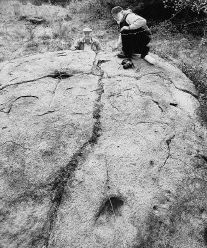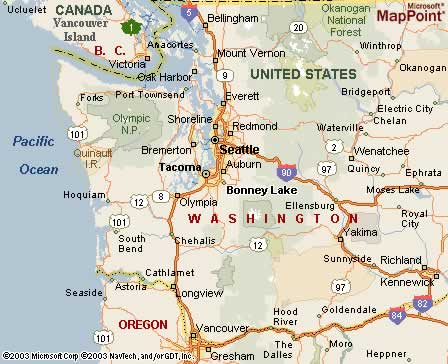|
|
Canku Ota |
|
|
(Many Paths) |
||
|
An Online Newsletter Celebrating Native America |
||
|
February 7, 2004 - Issue 106 |
||
|
|
||
|
City Preserves Historic Tribal Observatory |
||
|
by Rob Tucker; The
(Tacoma. WA) News Tribune
|
||
|
credits: Dennis
Regan, left, and Gerald Hedlund demonstrate the alignment of pits
on the Skystone near Bonney Lake in relation to the stars in 2000.
Photo by Peter Haley - News Tribune File
|
|
Now the monolith, called Skystone by the experts who discovered its function, squats on the edge of Naches Terrace, a 46-home development under construction. Where the silence of the forest once prevailed, noise from nail guns, moving trucks and lifting cranes cuts through the misty morning air. The Bonney Lake Historical Society wants to help people learn about the history that's represented by the rock, a centuries-old observatory and seasonal calculator. Historical society members have asked the city to pay for a directional road sign, as well as a plaque or monument placed near the rock that explains its significance. The rock and the surrounding development now reside in the city. "There are historic things in Bonney Lake," said Jennifer Whipkey of the historical society. "People like this kind of stuff. People can get in touch, feel a connection." The City Council said last week that it would be receptive to a proposal from the society. The city required the home developer to fence and protect the parallelogram-shaped stone, which is 4 1/2 feet high and about 12 feet across. The dark gray rock is common in morainic rock, or sediment left behind in the wake of a glacier. It's now enclosed in a cyclone fence with a gate and is located near the top of a high ridge along a gravel nature trail. The rock's flat top surface is now covered with moss and partially overshadowed by branches of a small tree. The Puyallup Tribe of Indians believed for many years that the rock had cultural and historical significance. Archaeologist Gerald Hedlund and retired astronomer Dennis Regan examined it and said it had scientific significance as well. They presented their findings at a meeting of experts in Spokane in 2000. Ancient people carved out 20 holes on the top surface with other stones and used sticks and rocks in the holes or cordlike material to connect the holes. The scientists used computer models based on the alignments to make their discoveries:
At least 200 years ago, ancestors of the Puyallups had artificially fashioned the rock for such purposes and possibly for religious and educational reasons as well, the scientists said. These kinds of ancient observatories have been found elsewhere, from Idaho to Mexico. Known as "sun daggers," they were built by ancient Indian tribes. Brad Martin lives in a new home down the hill from Skystone and has heard about it. "It's a tribal rock," he said last week as he pointed up the hill to the tall fence around the monolith. "They would use it to determine when to fish, the time of day, the year." City Councilman Dan Swatman said the nature trail that provides access to the rock is open to the public. Historical Society members will consult with the Puyallup Tribe of Indians, develop wording for the plaque, look at potential costs and make a presentation to the City Council at a later date. The site is registered with the state Office of Archaeology and Historic Preservation, state archaeologist Robert Whitlam said. Rob
Tucker: 253-597-8374 |
|
|
www.expedia.com |
|
|
||
|
|
||
| Canku Ota is a free Newsletter celebrating Native America, its traditions and accomplishments . We do not provide subscriber or visitor names to anyone. Some articles presented in Canku Ota may contain copyright material. We have received appropriate permissions for republishing any articles. Material appearing here is distributed without profit or monetary gain to those who have expressed an interest. This is in accordance with Title 17 U.S.C. Section 107. | ||
|
Canku Ota is a copyright © 2000, 2001, 2002, 2003, 2004 of Vicki Lockard and Paul Barry. |
||
 |
 |
|
|
The "Canku Ota - A Newsletter Celebrating Native America" web site and its design is the |
||
|
Copyright © 1999, 2000, 2001, 2002, 2003, 2004 of Paul C. Barry. |
||
|
All Rights Reserved. |
||
 A
large, flat-topped stone that ancestors of the Puyallup Indians
probably used as an observatory once sat in a hilly meadow fringed
by forest, just south of Bonney Lake.
A
large, flat-topped stone that ancestors of the Puyallup Indians
probably used as an observatory once sat in a hilly meadow fringed
by forest, just south of Bonney Lake. 